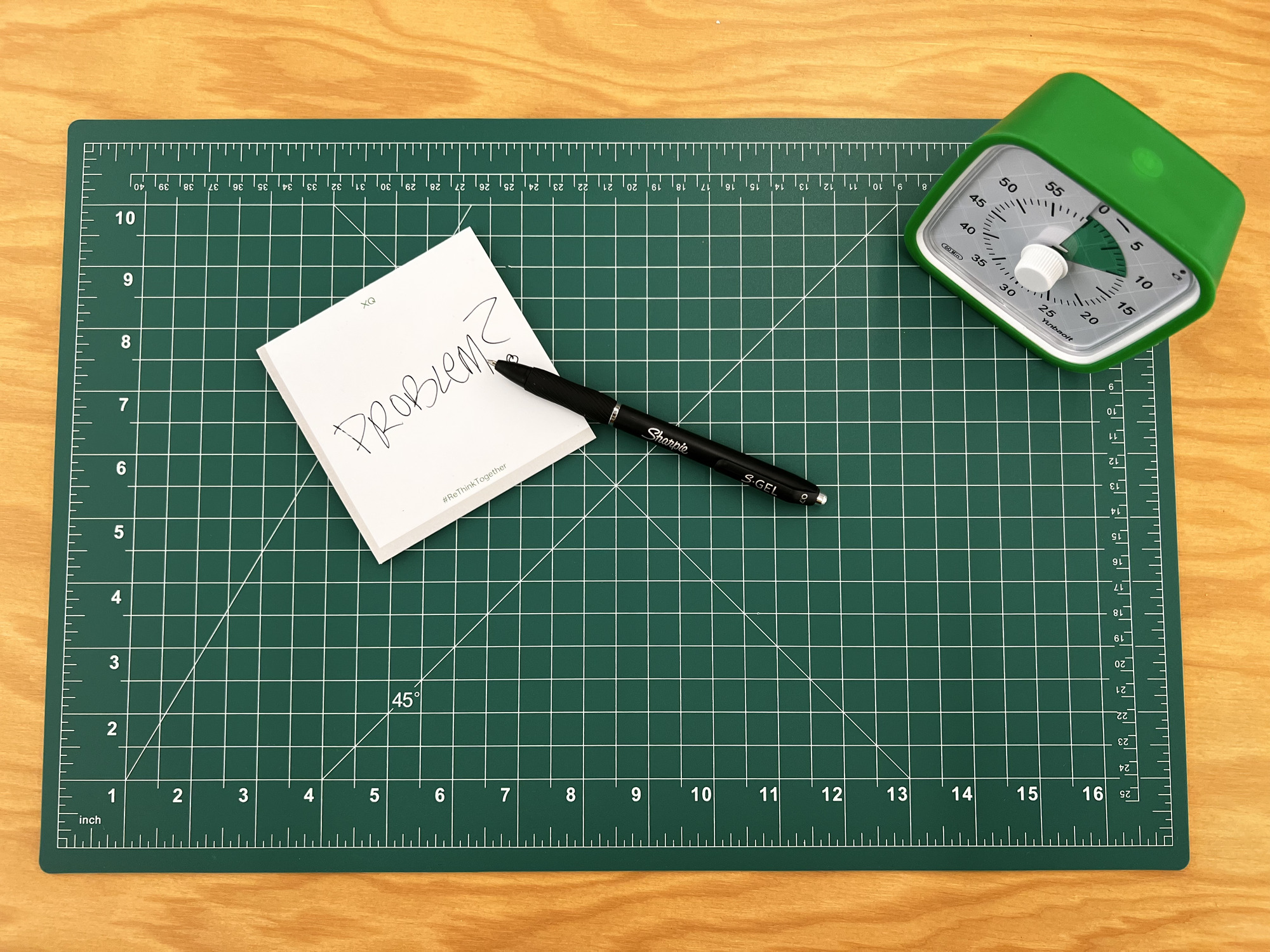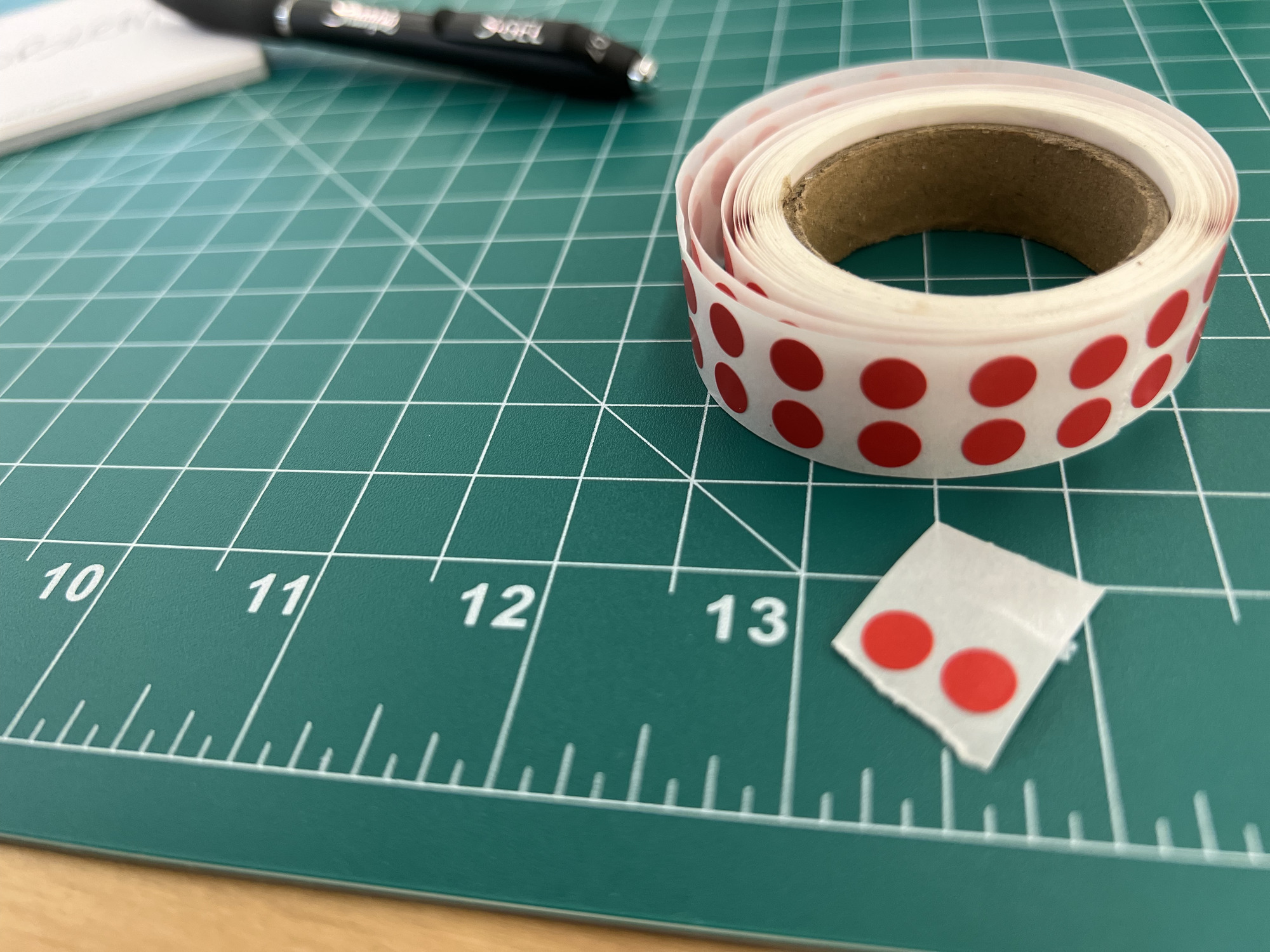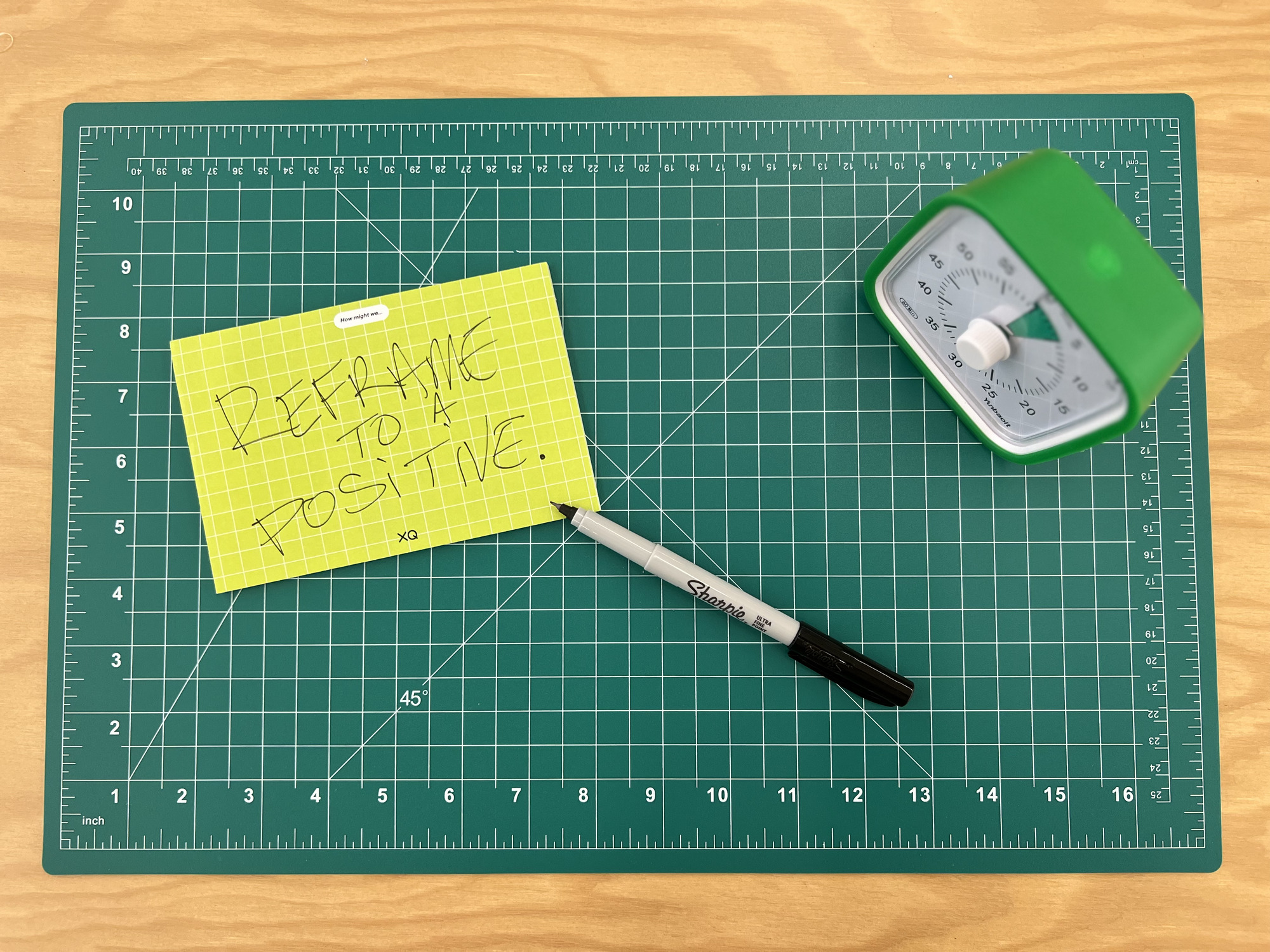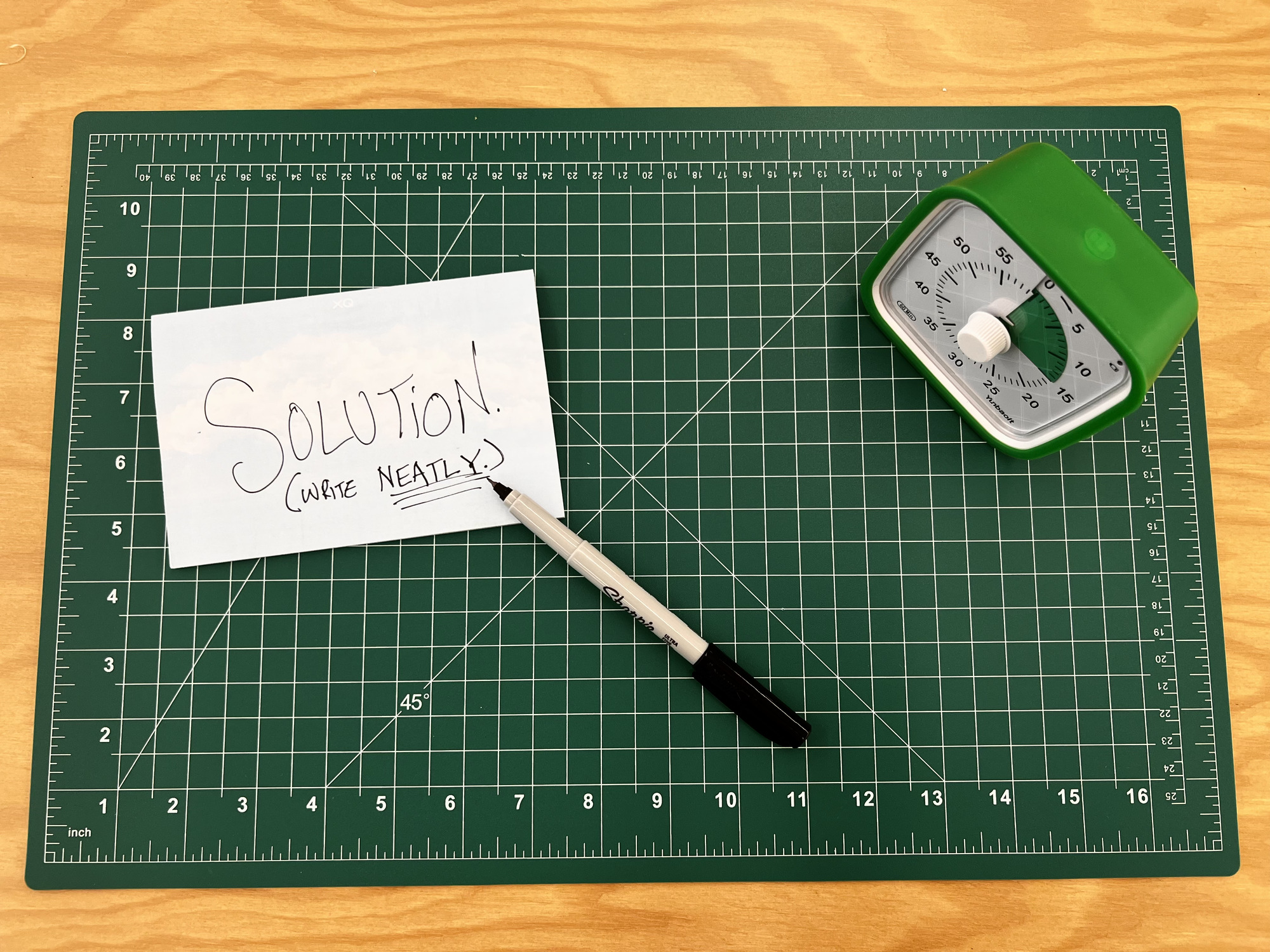🟢 Introduction
Strategic Framing
Problem Statement
Objectives
Advisors Attendees
Why this workshop structure?

Procedures
- Review materials
- Announce roles:
- 1 Facilitator: guides the exercise
- 1 Note-taker: captures real-time notes and takes photos of the output
- 8-9 Advisors: Provide domain expertise
- Encourage Advisors to log into the Team’s Notion to contribute, especially to add links/resources in the “Notepad” sections
- Conduct icebreaker
- Establish norms for the rest of this day
- Focus, to the fullest extent possible.
- We each have a voice at this table.
- This is our opportunity to take risks. Embrace wild ideas.
Timer [seated]
Materials
- AV for Note-taker to share Notion on screen
- Post-its (plain white rectangular)
- Sharpies (writing material)
- Rolling easel
- Personal mat to place Post-its
- Sticker dots for voting
- Virtual and physical timer
Outcomes
- Teams are familiar with each other
- Teams understand the exercise and materials they will be using
FACILITATOR AND NOTE-TAKER GUIDELINES Total time available: 10 min - Overview: 5 min - Ice breaker: 5 min Icebreaker format: - State your name - What do you do for work / where do you work?

Procedures
- Within 5 minutes, each Advisor writes down as many problems or challenges they perceive:
- INSIDE OF THE HIGH SCHOOL CLASSROOM or IN HIGH SCHOOL EDUCATIONAL SYSTEM
- Example: “High schools are failing our students in math, they can’t relate and it is boring for them.”
Notes:
- Use one Post-it for each problem/challenge
- You will select up to 5 problems/challenges to share with the Team
Timer [seated]

Materials
- AV for Note-taker to share Notion on screen
- Post-its (plain rectangular)
- Sharpies (writing material)
- Rolling easel
- Personal mat to place Post-its
- Virtual and physical timer
Outcomes
- Each Advisor has at least five problems/challenges written down on Post-its
FACILITATOR AND NOTE-TAKER GUIDELINES Total time available: 5 min Note-taker will take a photo of each advisor’s board of post-its 📷 and upload all of them to this section of the Notion section.

Procedures
- Each Advisor selects up to 2-3 problems/challenges to share with the Team, spending ~30 seconds on each problem/challenge (3 mins max per Advisor)
- After each Advisor shares, Facilitator takes the Post-its and attaches them to the rolling easel, grouping common problems/challenges together
/w=3840,quality=90,fit=scale-down)

Timer [seated]
Materials
- AV for Note-taker to share Notion on screen
- Post-its (plain rectangular)
- Sharpies (writing material)
- Rolling easel
- Personal mat to place Post-its
- Virtual and physical timer
Outcomes
- The team has an idea of all problems/challenges inside high school classrooms or the high school educational system
- Problems/challenges are grouped by commonality
FACILITATOR AND NOTE-TAKER GUIDELINES Total time available: 30 min - Each Advisor: 3 min max Reminders Facilitator should: - Remind others to respect the time constraint and to listen to the shared problems/challenges - Track the time for each Advisor - Collect the Post-its from each Advisor - Group common post-its together Note-taker should: Summarize each Advisor’s conversation on the shared problems/challenges
- Unintended AI consequences of tools and systems
- Students need to be intellectually engaged to develop skills needed for life. What happens when all of these tools remove the cognitive load to develop critical thinking?
- AI signals to high school students that learning to think is futile
- (e.g., what would be the point of learning how to write an essay or doing research on a time period in history if AI can do it for me?)
- Do AI tools contribute to decreased attention spans? How can we refocus tool to buy back their attention on what matters?
- Poverty and other conditions are more likely to predict student outcomes than grades on a high school diploma. Kids no longer understand the value of school, especially when they know it doesn’t guarantee economic mobility.
- Universities don’t have a way to translate “innovative” schools and practices, so it can become a barrier for scaling new pedagogy if attention and energy is focused on meeting standards
- Balancing urgency to scale and meeting systems/teachers/students where they are today. How do we do this when system incentives don’t encourage innovative solutions? (e.g., school labs not meeting infrastructure code)
- Teamwork and student powers aren’t valued. There’s missed opportunity in working in a community and pulling from strengths of students for systemic change
- Teacher support across domains and no standard practices in professional development. It’s a very typical scenario that a teacher with a history background finds themselves having to teach math. How can we expect a certain quality of teaching in this use case?
- Need clearer use cases of AI between students and teachers. We can assume a teacher has some level of foundational knowledge and judgement to understand what’s helpful and what’s garbage, but we cannot think students have developed the ability to make those distinctions. Again, that connects back to an earlier point made if AI replaces the intellectual development required than is it more harmful to learning?
- Point of tension — does PBL shortcut foundational learning (assuming found in more traditional methods of teaching)? The response: if coursework is disconnected to student experience, then yes. If coursework is authentic and relevant, then no. In other words, when it works, it really works, but when it doesn’t there’s potential downfall that a student may be worse off.
- There’s a need to refocus on the delivery of learning experiences, regardless of the learning science to find students on platforms they already engage on. Polymath is a great example of someone who’s delivering content in a more traditional way, but in short-form video on tiktok even when it’s content that’s not typically appealing (e.g., nonlinear algebra)
- Creative Hustle with Stanford D Lab is one example proving that distribution models matter. This may signal that the distribution may be more important than the design in transforming learning
- Teacher to student ratio. Clarification that this means the number of relationships per teacher, and not just having more teachers per student. So, if the ratio is 1 teacher to 100 students, can that teacher have the same 100 students all day versus 100 different students for each class?
- How can teachers personalize learning at the breadth and depth that’s required to maximize student interest and engagement?
- How can AI be used for teacher training via avatars? Could avatars mimic particular teaching styles, skill levels, or ability? Innovation of this nature can cause a point of tension because it comes at a cost of the student or teacher guinea pigs.
- Teacher pipeline, workforce talent, barriers to entry and pay
- Interesting POV: in Germany, barrier to entry is really high
- In California, teacher turnover rate is a major concern. New teachers leave the profession within the first five years.
- Important to note the types of teachers that are the majority of the workforce, which tell us that there’s a need to design for an inexperienced teaching pool
- Teacher pay is incredibly low
- How do we truly democratize the resources and materials that are coming into the world to transform learning?
- It’s clear there have been more investments in highjacking student attention than investments in student education
- How do we give students choice as we balance the natural consequence of over compliance and data collection with the ownership and individuality students need on their learning?
- There’s a need for trusted teachers and school leaders to be stewards of this data. How do we make it clear to students how its going to be used and give them real choices in this process?
- People become teachers because they enjoy working with youth or because their intellectuals of their domain
- Allocation of funds in school systems. What do we do when resource allocation is driven by political agenda and greed?
- There’s a need for better school leaders, who have had experience in the classroom, who listen to teachers in their schools.
- Trusted advisors in the school systems is key for student support and development beyond high school. When a trusted teacher or leader cares about a student and can tell them the reality they face in pursuing their ambitions, that can make a world of a difference. If they can help model conflict resolution, that’s even better.
- What is the value prop of the diploma? Does innovation in schools on the coasts really cover the problems faced by the challenges of schools in middle America?
- Systemic failures — how do we nurture curiosity and continue to innovate in the face of so many environmental challenges (e.g., gang violence, student safety, over/under policing in schools, student hunger, raising siblings). It’s tough to innovate and build solutions for education when a lot of the issues are tied to systemic issues related to poverty and safety.
- Comparison of high school transformation to Amazon Go and the need for sidewalks. List of twelve reasons why sidewalks are a game changer in student outcomes starting with obvious reasons like not getting hit by a bus, but then very quickly become specific and real to the likelihood of a student taking a wrong turn in an unfamiliar and potentially risky area.
- Teacher labor markets — geared towards keeping high quality teachers and removing poor quality teachers.
- Should we be talking about removing democratic control of an entire school system? Allocation of funds are dictated by board members and school leaders, and their motivations are to serve the interest of the broad community. This is a feature and not a bug of the system.
- A need to be very real and transparent about career opportunities and life beyond high school. Great example shared about students wanting to become NFL players, which statistically speaking, is quite low. How do we support student ambitions, prepare them for the real world and giving them skills to have options later on? This connects to the value proposition of school — if students/parents/communities believed that school was actually interesting and cool, the downstream effect would be that students can uncover the number of possibilities for their futures
- High school students feel so connected to Gary V because he teaches in a way that starts with self-awareness, social-emotional skills, personal goal setting, happiness, optimism, which is SO attractive to young people because school doesn’t do that.
- Need a balance between meeting students where they are (via social media platforms) and using it as a place to capture student interest versus completely innovating in isolation outside of those forces. (e.g., encouraging use of social media in student-led projects to teach responsibility)

Procedures
- Each Advisor receives two red dots to vote on the most pressing problems, doing so silently

- Facilitator moves the top 3 problems/challenges based on the number of votes to the middle of the easel

Notes:
- If there is a tie-breaker, Advisors will vote for the top problem/challenge by using their hand
Timer [standing]

Materials
- AV for Note-taker to share Notion on screen
- Post-its (plain rectangular)
- Rolling easel
- Virtual and physical timer
- ¼ inch dot stickers (round and red color)
Outcomes
- Advisors vote
- Top 3 problems/challenges are identified
FACILITATOR AND NOTE-TAKER GUIDELINES Total time available: 5 min Facilitator reminds Advisors to vote silently

Procedure
- The top 3 problems/challenges are rephrased by the original author outloud to the Team. The team works to reframe the problem into a "How might we...?" statement.

Example:
Problem: “We have no means of measuring the efficacy of these AI tools my students are using."
Reframed: "How might we create means of measurement and efficacy of AI products?"
Timer [standing]

Materials
- AV for Note-taker to share Notion on screen
- Post-its (plain rectangular)
- Rolling easel
- Virtual and physical timer
Outcomes
- There are 3 “How might we…” statements and they are captured in the Team Notes section
FACILITATOR AND NOTE-TAKER GUIDELINES Total time available: 5 min Note-taker captures the “How might we...” statements

Procedure
- Brainstorm. Allowing 5 mins for each of the top problems/challenges, each Advisor writes down as many solutions they have for the specific problem/challenge
- The format for Solutions on a Post-it should be no more than 3 sentences, which sounds similar to an “elevator pitch”
- Given the current landscape of companies and AI products, hold space for how technology may play a role in each solution Post-it
- Example solution: “Build the most dynamic curriculum on becoming an Entrepreneur; using AI co-pilot trained on insights from world-famous business leaders.”
- This process will be repeated for the problem/challenge, totaling 15 mins
- Shareout. Each Advisor selects up to 2 solutions to share with the Team, spending 1:30 min max per advisor on sharing solutions (~30 secs on each solution). Limit to three sentences “elevator pitch.”
- Sorting. After each Advisor shares, Facilitator takes all solution Post-its from the Advisor and attaches them to the rolling easel. Team reads all solutions and [if applicable] Team supports in sorting common solutions under each problem/challenge

Timer [seated]

Materials
- AV for Note-taker to share Notion on screen
- Post-its (plain blue rectangular)
- Sharpies (writing material)
- Rolling easel
- Personal mat to place Post-its
- Virtual and physical timer
Outcomes
- All solutions are sorted and presented under each of the top 3 problems/challenges
FACILITATOR AND NOTE-TAKER GUIDELINES Reminders Facilitator should: - Encourage as many solutions to be written. No pressure on “over” designing - Reminder others to respect the time constraint and to listen to the shared problems/challenges - Track the time for each Advisor - Collect the Post-its from each Advisor Note-taker should: Summarize each Advisor’s conversation on the solutions

Procedure
- Each Advisor receives 5 red dots to vote on the most appealing solutions, doing so silently

Notes:
- If there is a tie-breaker, Advisors will vote for the top problem/challenge by using their hand
- Only 1 vote per solution
Timer [standing]
Materials
- AV for Note-taker to share Notion on screen
- Post-its (plain rectangular)
- Rolling easel
- Virtual and physical timer
- ¼ inch dot stickers (round and red color)
Outcomes
- At least 3 solutions are identified via votes
FACILITATOR AND NOTE-TAKER GUIDELINES Total time available: 5 min

Procedures
- Facilitator selects at least 3 and at most 5 of the most voted-on solutions and moves them to the top of the matrix side of the easel

- Advisors discuss each of the solutions to determine the feasibility and place the solution on the “Effort vs. Impact” matrix
- Vertical axis: level of impact of the solution
- Horizontal axis: level of effort required to create the solution

- Each Advisor receives 1 green dot to vote on the most appealing solution from the matrix, doing so silently
- By the end of this session, the team has landed on one idea to build a roadmap for.

Notes:
- The objective of this exercise is to gather consensus, if not a majority, on where to place each solution on the matrix
Timer [standing]
Materials
- AV for Note-taker to share Notion on screen
- Rolling easel
- Virtual and physical timer
- ¼ inch dot stickers (round and green color)
Outcomes
- Top solutions are on the effort vs. impact matrix with their votes
FACILITATOR AND NOTE-TAKER GUIDELINES Total time available: 20 min - Placing solutions on matrix: 15 mins - Vote on matrix: 5 mins

Procedures
- The facilitator rolls the Team’s easel to the general area for viewing.
Side 1: Problems/challenges & solutions
- Grouped problems/challenges
- Voted on top 3 problems/challenges
- All possible solutions under each of the Top 3 problems/challenges
Side 2: Mapped matrix
- Quadrant with at least the top 3 solutions plotted based on effort vs. impact
Timer [walk]
Materials
- Rolling easel
- General area for a break
- Coffee, tea, biscuits break
Outcomes
- Advisors have scanned the problems/challenges, solutions, and mapped matrices from the other Teams
FACILITATOR AND NOTE-TAKER GUIDELINES Total time available: 15 min Facilitator should guide the Team back to workspaces Note-takers should take a photo of all easels

Green team! Now go Build your Final Team Reports!
/w=3840,quality=90,fit=scale-down)



/w=3840,quality=90,fit=scale-down)
